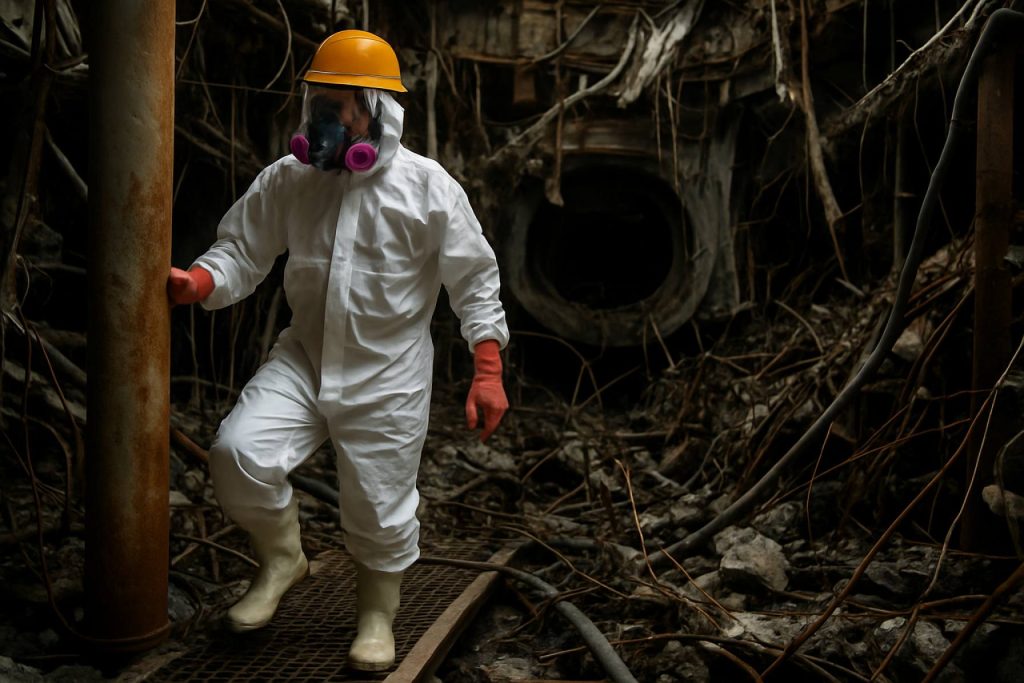
- A 22-meter, 18-jointed robotic arm is central to Fukushima Daiichi’s nuclear cleanup, designed to navigate extreme radioactive hazards and extract molten reactor fuel debris.
- More than 880 tons of radioactive fuel debris remain inside reactors, posing major technological challenges for decommissioning that could last beyond mid-century.
- Repeated setbacks—including cable failures and operational hazards—underscore the complexity and danger of remote-controlled nuclear decommissioning.
- Japan’s approach highlights both pioneering innovation and the immense burden of nuclear disaster recovery, influencing global nuclear safety standards.
- The project reflects both resilience and caution, serving as a compelling example of how technology, responsibility, and humility must coexist in managing nuclear crises.
Beneath layers of steel and decades of trauma, a silent behemoth waits at Fukushima Daiichi—a place few have glimpsed since disaster struck in 2011. Here, far below the No. 5 reactor’s battered shell, a 22-meter robotic arm—an industrial serpent with 18 nimble joints—stands ready to pierce one of the world’s most toxic labyrinths. This machine, weighing as much as an African elephant and painstakingly engineered by a Japanese-British alliance, embodies both high hopes and hard truths in Japan’s battle with the legacy of its worst nuclear accident.
Eleven years after a tsunami remade the northern coastline and crippled the No. 1 plant, recovery crews still confront one daunting fact: nearly 880 tons of molten reactor fuel debris festers inside reactors No. 1, 2, and 3. Extracting this radioactive mass is the technological Everest of the decommissioning process—an undertaking that could extend past mid-century. The robotic arm is the latest hero drafted for this Sisyphean task. Its articulation, achieved through 18 joints, should allow it to snake through an unforgiving 55-centimeter-wide opening, then curl and lower its four-meter-long tip toward the most dangerous material on Earth.
Yet, each step closer reveals more hazards. Test runs in recent months exposed new flaws: disintegrating motor cables, a wobbling extension prone to perilous sways, and near-misses with the reactor’s jagged interior. Developers from Mitsubishi Heavy Industries and engineers funded by 7.8 billion yen in public money have spent years battling inertia and gravity—with setbacks accumulating like dust in the shadowed corridors of the plant.
The operational environment rivals the scale of the challenge itself. According to technical briefings, even a minor miscalculation can send the robot’s immense appendage crashing into delicate infrastructure—risking delays or worse, breaches that could release radioactive material. Real-time remote navigation, meanwhile, demands steady nerves; heart rates spike as the robotic joints flex and twist, squeezing through spaces no human dare approach.
Multiple delays—four and counting—have eroded some optimism, replaced by a nervous vigilance among project managers and nuclear safety leaders. Dismantling work to inspect ailing cables will continue into the spring, with hopes pinned on new tests in the coming months. Throughout, debate persists: Should Japan press on, doggedly refining a device no company in the nation’s tainted nuclear history has mastered? Or admit defeat and chart a new path before time and radiation claim their toll?
What shines through this technological drama is not only the resilience of those crafting tomorrow’s tools from today’s adversity, but the sobering demands of responsibility. The painstaking care shown here reflects Japan’s broader attitude toward nuclear stewardship, which remains a touchstone issue for the country and the world. Failures and successes alike will reverberate through the global nuclear industry, shaping standards for decommissioning and disaster response for decades.
Key Takeaway: The ongoing drama of Fukushima’s robotic arm highlights both the determination and daunting reality of cleaning up after nuclear catastrophe. As Japan approaches another crossroads in its radioactive odyssey, the lessons drawn here carry weight far beyond its shores, reminding us how innovation must be wedded to humility in the face of daunting unknowns.
For a global view on nuclear policies and safety, official resources such as the International Atomic Energy Agency and Japan’s Ministry of Economy, Trade and Industry offer up-to-date insights into the challenges and hope guiding Fukushima’s next chapter.
Inside Fukushima’s Mechanical Serpent: The Untold Story and Future Challenges of the Nuclear Cleanup Robot
Japan’s futuristic 22-meter robotic arm, hidden in the radioactive depths of Fukushima Daiichi, has captured the world’s attention. But beyond its mechanical marvels, there are urgent questions and critical lessons not yet explored. Dive deeper into the science, controversy, and future implications behind this unprecedented nuclear cleanup.
Unveiling New Facts: What the World Needs to Know
1. Scale and Complexity of the Debris
– The 880 tons of fuel debris inside Reactors 1, 2, and 3 are composed of a volatile mix of melted uranium fuel, zirconium cladding, and steel structural supports. According to the IAEA, such “corium” formations have never been removed on this scale ([source](https://www.iaea.org)).
– High radiation levels—upwards of 530 sieverts per hour in some areas—render the site lethal for humans without heavy shielding and strict time limits.
2. Robotic Arm: Features, Specs & Pricing
– Joints: 18 independently-controlled segments for maximum articulation.
– Total Reach: 22 meters (~72 feet); tip precision within millimeters.
– Weight: Over 4 tons (comparable to an African elephant).
– Cost: Estimated over ¥7.8 billion (approx. $60 million USD).
– Design Partnership: Mitsubishi Heavy Industries and International Nuclear Services (UK).
3. Security and Sustainability Concerns
– Cybersecurity: As remote operations increase, cybersecurity threats (e.g., hacking or remote sabotage) have become significant, prompting partnerships with Japan’s national cybersecurity agencies.
– Waste Management: Extracted debris remains highly radioactive for decades and must be securely stored, often in underwater or dry cask containment. The hunt for a final disposal site is ongoing, with community and environmental concerns at the forefront.
4. Industry Trends & Global Echoes
– Robotics in Nuclear Cleanup: Global interest is surging. Chernobyl, Three Mile Island, and the Sellafield site in the UK have all seen a rise in robotics for hazardous material removal ([encouraged by the IAEA](https://www.iaea.org)).
– Market Growth: The nuclear decommissioning robot market is projected to grow at a CAGR of 10–12% through 2030, thanks to aging nuclear fleets and stricter safety standards.
5. Controversies & Limitations
– Delays and Cost Overruns: This is the latest in more than four announced delays; each setback increases public skepticism.
– Technological Hurdles: Vibration, cable degradation from radiation, and navigation in cramped, debris-filled spaces remain persistent risks.
– Public Trust: Surveys by Japan’s NHK reveal that more than half of the local population remains opposed to restarting reactors, citing safety doubts.
6. How-To Steps & Practical Advice for Nuclear Decommissioning Teams
1. Pre-Survey the reactor interior using remote-controlled drones and gamma cameras.
2. Precisely engineer robotic appendages resistant to high-dose radiation fields (using tungsten alloys and lead shields).
3. Regularly test joints and cables for degradation before live operations.
4. Train operators in high-fidelity virtual simulators simulating delay and sensory overload.
5. Develop contingency plans for mechanical failures—including secondary retrieval robots and redundant power supplies.
7. Real-World Use Cases
– The Fukushima arm’s tech has inspired miniaturized versions for removing hazardous debris from industrial chemical spills, underwater construction, and even space missions (e.g., the ESA’s decommissioning robots on the ISS).
8. Reviews, Comparisons & Predictions
– Compared to Chernobyl, Fukushima’s robotic solutions are far advanced—offering fine movement rather than crude, single-purpose machines.
– Experts predict the first kilogram of fuel debris from Reactor 2 to be removed no earlier than 2025, with full decommissioning likely extending to 2060 or beyond ([source: World Nuclear News](https://www.world-nuclear.org)).
9. Pros & Cons Overview
Pros:
– Dramatically reduces human exposure.
– Adaptability to unknown reactor interior conditions.
– Sets global safety benchmarks.
Cons:
– High technical risk and cost.
– Limited field-proven experience for such extensive cleanup.
– Public unease and skepticism about nuclear energy persist.
Pressing Questions Answered
How long until Fukushima is truly safe?
Estimates by TEPCO, Japan’s nuclear operator, suggest full decommissioning will take 30–40 more years, contingent on technology advances.
Could similar disasters be handled faster elsewhere?
Only if robotic and AI-guided decommissioning systems become more autonomous, robust, and less dependent on human teleoperation.
What happens to removed radioactive debris?
Long-term storage solutions are still under negotiation, with interests in both on-site dry cask storage and eventual geological repository placement ([reference: IAEA](https://www.iaea.org)).
What’s the global impact on nuclear energy policy?
The Fukushima crisis set off a wave of nuclear phase-outs (e.g., Germany) and safety upgrades worldwide, making robotics central to future plant life cycle management.
Actionable Recommendations & Quick Tips
– For nuclear operators: Invest in modular, upgradable robotics; establish multi-contingency emergency protocols.
– For policymakers: Support transparent reporting and continued funding for safety innovations.
– For the public: Stay informed via credible agencies like the International Atomic Energy Agency and industry regulators ([METI](https://www.meti.go.jp)).
– For engineers and students: Gain skills in robotics, radiation-hardened electronics, and AI for high-risk environments.
—
Fukushima’s robotic saga is a crucible for nuclear industry lessons: precise technology, robust contingency planning, and public communication are paramount. The world is watching, and the stakes could not be higher—both for Japan and global nuclear safety standards.



